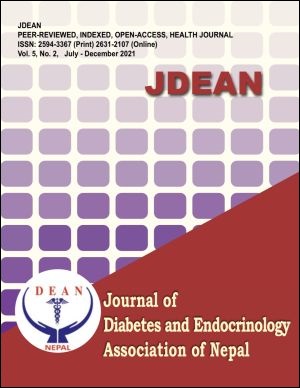Relationship between Body Fat Percentages by Bioelectrical Impedance Analysis and Body Mass Index (BMI) And other metabolic Parameters among Filipino Adults At Emilio Aguinaldo College Medical Center- Cavite
DOI:
https://doi.org/10.3126/jdean.v5i2.43395Keywords:
Bioelectrical Impedance Analysis, Percent Body Fat, Metabolic variablesAbstract
Background: Obesity posing burgeoning risk for mortality, diabetes mellitus, cardiovascular diseases and cancer among fast ageing Filipino population must be accurately measured by the use of rapid, non-invasive, digitally precise tool, Body Fat percentage and segmental body composition obesity predictors in Bioelectrical Impedance Analysis where overseas studies established significant but limited results. Our study focused on Filipino group with the correlation of its body fat percentage and other obesity predictors set in BIA therein like Free Fat Mass, Fat, Bone and Muscle masses, visceral fat amongst others, with Body Mass Index and other conventional obesity measurements.
Method: This cross-sectional, correlational study included 363 Filipinos, patients and employees of Emilio Aguinaldo College Medical Center- Cavite and nearby health center, 18-80 years of age, BMI of 16-34, excluded those pregnant and bearing metallic body implants, have imparted their History, level of activity. Installed Standardized protocol for Physical Examination, measurements of height, weight, Body mass index waist and hip circumferences, waist-hip ratio, systolic blood pressure and diastolic blood pressure.
Results: All BIA measurements used Tanita MC980. The Pearson correlation coefficients, Binary logistic regression analysis, two tailed test, Shapiro-Wilk tests analyzed 137 Males, 226 females with mean age of 34.64, p-value of 0.29, showed strong, significant correlation between BFP and BMI, and other measurements, where BMI had strongest correlation to women than men with synonymous correlation with other metabolic variables and predictors, and no significant difference between genders.
Conclusion: Our research reflected that Body Fat Percentage have strong significant correlation with BMI, metabolic variables and obesity predictors measured, established a better estimate for obesity as compared to the conventional measurements.
Downloads
Downloads
Published
How to Cite
Issue
Section
License
Copyright (c) 2021 J.K. Yadav, E. Sherwin, M. Baris, D. Pagsisihan, A. Baston, J.M. Sembrano

This work is licensed under a Creative Commons Attribution-NonCommercial 4.0 International License.
This license enables reusers to distribute, remix, adapt, and build upon the material in any medium or format for non-commercial purposes only, and only so long as attribution is given to the creator.




